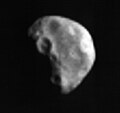پەڕگە:Dactyl-HiRes.jpg

قەبارەی ئەم پێشبینینە: ٦٣٦ لە ٦٠٠ پیکسەڵ. ڕێزەلووشنەکانی تر: ٢٥٥ لە ٢٤٠ پیکسەڵ | ٥٠٩ لە ٤٨٠ پیکسەڵ | ٨٩٢ لە ٨٤١ پیکسەڵ.
پەڕگەی سەرەکی (٨٩٢ × ٨٤١ پیکسڵ، قەبارەی پەڕگە: ٣٨٥ کیلۆبایت، جۆری ئێم ئای ئێم ئی: image/jpeg)
مێژووی پەڕگە
کرتە بکە لەسەر یەکێک لە ڕێکەوت/کاتەکان بۆ بینینی پەڕگەکە بەو شێوەی لەو کاتەدا بووە.
| ڕێکەوت/کات | ھێما | ئەندازە | بەکارھێنەر | تێبینی | |
|---|---|---|---|---|---|
| هەنووکە | ٠٤:٣٧، ٢ی نیسانی ٢٠١٨ |  | ٨٩٢ لە ٨٤١ (٣٨٥ کیلۆبایت) | PlanetUser | Cropped 20 % horizontally and 20 % vertically using CropTool with precise mode. |
| ١٩:٣٥، ١٢ی کانوونی یەکەمی ٢٠١٧ |  | ١٬١١٥ لە ١٬٠٥١ (٥٩٧ کیلۆبایت) | Newone | Better version | |
| ٢٣:٠٤، ٢٥ی ئایاری ٢٠١٠ |  | ٢٤٠ لە ٢٤٠ (١٦ کیلۆبایت) | Antonsusi | {{PD-USGov-NASA}} |
بەکارھێنانی پەڕگە
ئەم پەڕەی 2ە ئەم پەڕگەیە بەکار دەھێنێت:
بەکارھێنانی سەرانسەریی پەڕگە
ئەم ویکیانەی دیکەی خوارەوەش ئەم پەڕگە بەکاردێنن:
- بەکارھێنان لە af.wikipedia.org
- بەکارھێنان لە ar.wikipedia.org
- بەکارھێنان لە ary.wikipedia.org
- بەکارھێنان لە arz.wikipedia.org
- بەکارھێنان لە az.wikipedia.org
- بەکارھێنان لە be.wikipedia.org
- بەکارھێنان لە bh.wikipedia.org
- بەکارھێنان لە bs.wikipedia.org
- بەکارھێنان لە ca.wikipedia.org
- بەکارھێنان لە cs.wikipedia.org
- بەکارھێنان لە de.wikipedia.org
- بەکارھێنان لە el.wikipedia.org
- بەکارھێنان لە en.wikipedia.org
- بەکارھێنان لە es.wikipedia.org
- بەکارھێنان لە fi.wikipedia.org
- بەکارھێنان لە fr.wikipedia.org
- بەکارھێنان لە hy.wikipedia.org
- بەکارھێنان لە id.wikipedia.org
- بەکارھێنان لە it.wikipedia.org
- بەکارھێنان لە ja.wikipedia.org
- بەکارھێنان لە ko.wikipedia.org
- بەکارھێنان لە kv.wikipedia.org
- بەکارھێنان لە la.wikipedia.org
- بەکارھێنان لە lb.wikipedia.org
- بەکارھێنان لە lt.wikipedia.org
- بەکارھێنان لە mk.wikipedia.org
- بەکارھێنان لە ms.wikipedia.org
- بەکارھێنان لە my.wikipedia.org
- بەکارھێنان لە nds.wikipedia.org
- بەکارھێنان لە ne.wikipedia.org
- بەکارھێنان لە nl.wikipedia.org
- بەکارھێنان لە no.wikipedia.org
بینینی بەکارھێنانی گشتی زیاتری ئەم پەڕگەیە.

